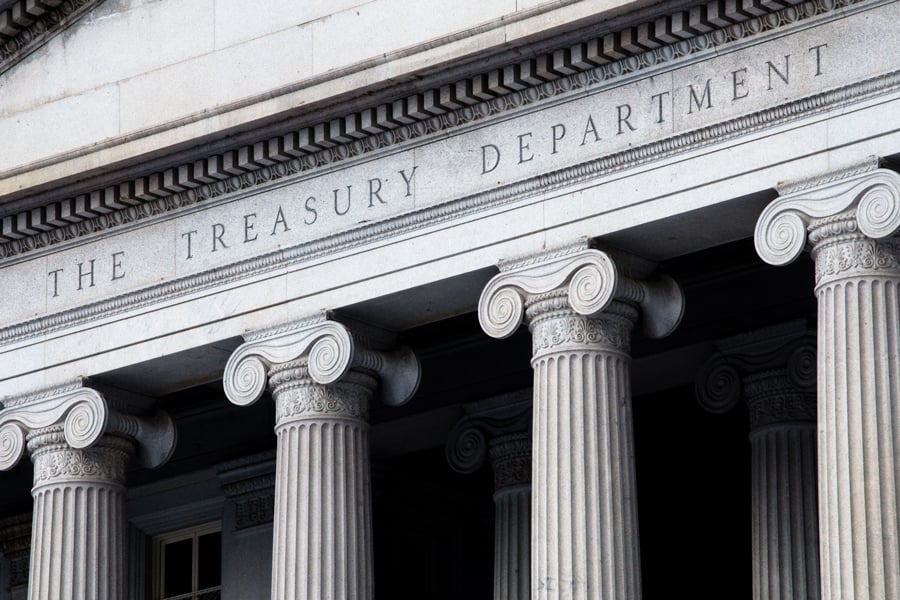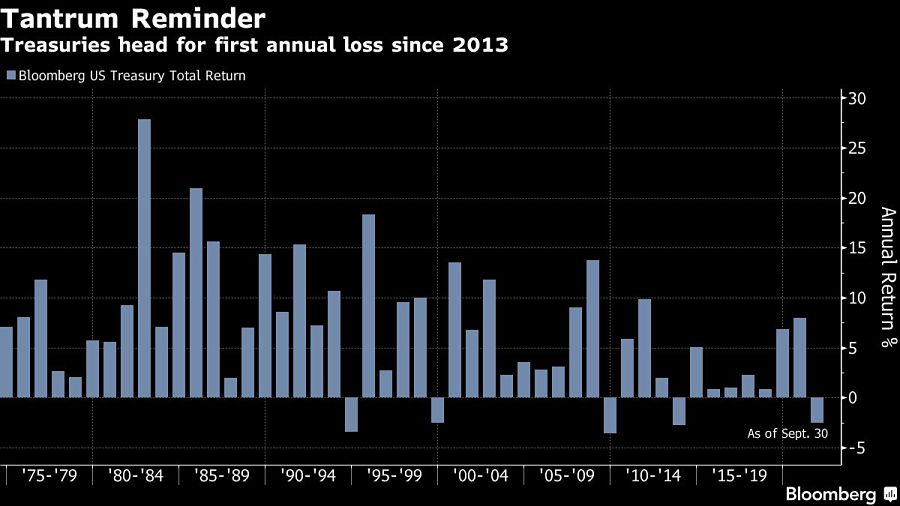

The Federal Reserve is doing its best to avoid a repeat of the taper tantrum of 2013 as it moves toward curbing its bond buying. Ironically for investors, 2021 could turn out to be an even worse year for the Treasury market than 2013.
The latest bond sell-off — triggered by a hawkish shift in the Fed’s signal on its policy path — has left the Bloomberg U.S. Treasury Index down 2.2% this year, on track for the first annual loss since 2013, when it declined 2.8%.
With key measures of inflation surging and coronavirus cases starting to ebb, investors and strategists from firms such as Societe Generale and UBS Group are bracing for more losses this quarter. Confidence in that view may only grow with the release of monthly jobs data Friday, which is forecast to show hiring accelerated in September.

“It may not be a straight line higher, but there’s some catchup to do” for bond yields, said Leslie Falconio, head of U.S. fixed-income asset allocation at UBS Financial Services. “Our expectation is that consumer demand will recover from the setback” of the past few months, when the resurgent virus slowed economic momentum.
Falconio expects 10-year Treasury yields to rise to around 1.75% by year-end, around their peak for 2021. The yield reached about 1.57% this past week — the highest since June — before buyers started to nibble.
After several months of stability, global bond markets started to slump last month after central banks including in the U.S. and the U.K. signaled a move to reduce pandemic-era stimulus to head off inflation.
Traders boosted bets that the Fed will start raising rates late next year and lift them almost three times by the end of 2023. A power crunch across Europe and China is also keeping bond investors on edge.
There are plenty of forces that could limit a further sell-off. Lawmakers are locked in a standoff over raising the U.S. debt ceiling, with the government weeks away from a possible default, in the estimate of the Treasury. And in China, growth is cooling amid a property market slowdown and a power shortage.
But so far, international investors don’t seem to be swooping in with significant purchases, a dynamic that has capped Treasuries declines in the past.
The market is hardly anticipating a repeat of the rout eight years ago, when then-Fed Chairman Ben Bernanke triggered a surge in yields after he suggested the central bank could begin to reduce asset purchases. In that episode, 10-year yields jumped more than 100 basis points in four months.
But traders are now turning to the September labor report for the next potential catalyst for higher yields.
With the Fed all but teeing up November as the likely timing of an announcement of a plan to reduce its asset purchases, the payroll report Friday could ratify that view by offering fresh signs of broad economic strength. The median forecast of analysts surveyed by Bloomberg is for a gain of 470,000 jobs in September, double the previous month.
Investors have been tilting toward an extended sell-off. A JPMorgan Chase & Co. survey showed that a net 25% of its clients were short Treasuries as of Monday, the most since early September.
“If we get a number close to the consensus, we see the potential for yields to rise in the back end,” said Subadra Rajappa, head of U.S. rates strategy at Societe Generale, who predicts 10-year yields will rise to 1.7% by year-end.

A new analysis finds long-running fiscal woes coupled with impacts from the One Big Beautiful Bill Act stand to erode the major pillar for retirement income planning.

Caz Craffy, whom the Department of Justice hit with a 12-year prison term last year for defrauding grieving military families, has been officially exiled from the securities agency.

After years or decades spent building deep relationships with clients, experienced advisors' attention and intention must turn toward their spouses, children, and future generations.

The customer’s UBS financial advisor allegedly mishandled an options strategy called a collar, according to the client’s attorney.

An expansion to a 2017 TCJA provision, a permanent increase to the standard deduction, and additional incentives for non-itemizers add new twists to the donate-or-wait decision.
Orion's Tom Wilson on delivering coordinated, high-touch service in a world where returns alone no longer set you apart.
Barely a decade old, registered index-linked annuities have quickly surged in popularity, thanks to their unique blend of protection and growth potential—an appealing option for investors looking to chart a steadier course through today's choppy market waters, says Myles Lambert, Brighthouse Financial.
